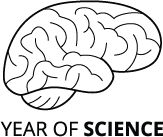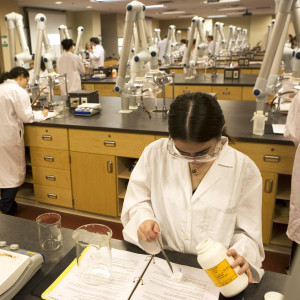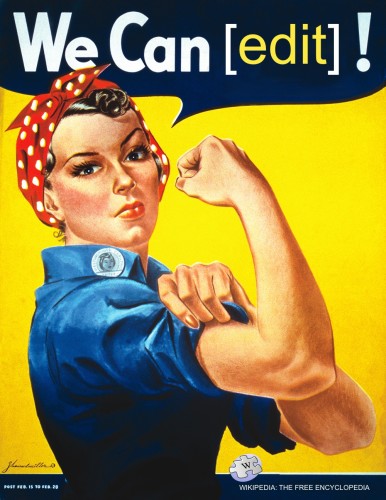The US Department of Education says that women earn 57.4% of bachelor’s degrees. Women receive 62.6% of master’s degrees. But only 31% of degrees and certificates in STEM fields go to women.
This gap has an uneasy, well-known counterpart on Wikipedia. Roughly 80–90% of the volunteers writing Wikipedia are men. It’s perhaps no coincidence that Wikipedia’s biographies of women are often lacking in quality – or don’t exist at all.
Wiki Education celebrates the idea that access to knowledge is a game-changer. We believe the same holds true for young women in STEM. The gap in Wikipedia’s coverage of women reflects worrisome stereotypes of women in science, but it’s also an unprecedented opportunity to challenge those stereotypes.
For anyone who cares about young women’s pursuit of STEM careers, this is crucial. Internalized stereotypes among women in STEM fields has mind-boggling and often non-obvious impacts. To break the glass ceiling, instructors must help young women break out of the glass box: the set of internalized limits that shapes their choice of careers.
Stereotype threat
In an experiment, men and women took an identical math test. Some were told that women didn’t do as well as men on the test. Others weren’t. When women were told that the test was harder for women, they performed worse than men. When women were told there was no difference, they performed identically.
That’s stereotype threat. When students feel that they’re at risk of reinforcing a negative stereotype, they become more anxious about their performance. They worry that they’re just another example of that cliche.
That can undermine test results in the short term. Sustained over time, this undermining of confidence can lead to women abandoning careers that don’t align with expectations of their gender, race, or class. Research has played out similar results for women over and over and over and over and over and over again.
These outcomes are heartbreaking, and there’s one particularly cruel twist. The more passionate a young woman is about succeeding in a STEM field, the more susceptible she’ll be to these negative stereotypes. Even women who know they’re good at math, and think math is important, can hold back when confronted with the idea that society thinks they won’t succeed.
This gendered priming starts young. It can be as subtle as being asked to draw a picture of a girl with a doll and a boy with a ball. Very young girls who drew stereotypical images of girls before taking a math test performed worse than girls who drew a landscape.
It’s not just math. Studies show an impact on women’s perceived abilities in leadership, engineering, and chess. It’s not just gender, either. The effect applies to stereotypes of black and Latino students, too.
When young women are exposed to stereotypes, it changes the way they talk about their dreams and careers. As Steele noted, “Women may reduce their stereotype threat substantially by moving across the hall from math to English class” (p.618). When young women give up their dreams, STEM fields give up an enormous pool of talent.
Why should students write women into Wikipedia?
 So, what does all of this have to do with Wikipedia, which is skewed toward men in both authorship and content? Surveys vary, but likely more than 80% of Wikipedians are men. A 2011 study showed that Wikipedia has a disproportionate number of biographical articles about men, and a more recent study showed that women with articles on Wikipedia often have to accomplish more to be included than men.
So, what does all of this have to do with Wikipedia, which is skewed toward men in both authorship and content? Surveys vary, but likely more than 80% of Wikipedians are men. A 2011 study showed that Wikipedia has a disproportionate number of biographical articles about men, and a more recent study showed that women with articles on Wikipedia often have to accomplish more to be included than men.
We see an opportunity to expand the number of women scientists on Wikipedia, and to open a discussion of stereotypes in STEM fields.
Consider Dr. Sherry Seston’s Virology class at Alverno College, a liberal arts women’s college. Students learned about virology, but also developed 18 biographies of women virologists on Wikipedia. Along the way, they learned about the traditional career paths of women in science.
“(Students) were angry and frustrated when there were so few women to choose from,” said Dr. Seston. “So we had to have a big discussion about the possible reasons this might be occurring, and what the National Science Foundation and other organizations are trying to do to address the problem.”
Wiki Ed’s Year of Science has a focus on developing biographies of women scientists. We’re asking instructors in higher education to assign students to write these biographies. We’re doing it because more women’s biographies on Wikipedia is important. But we also think it can help offset the impact of stereotype threat.
Four impacts
We believe a Wikipedia assignment presents four opportunities to tackle stereotype threat.
1) Researching Wikipedia’s coverage of women scientists presents an opportunity to discuss stereotypes. Women scientists are missing from the largest source of knowledge on the planet. That’s a chance to examine stereotypes, and explore women’s anxieties around academic performance.
2) It’s an opportunity to write about role models. That affirms, every step of the way, that women not only “can be” scientists, but are scientists. It consciously counteracts a lack of representations in other forms of media.
3) In writing about women scientists, students are exposed to career trajectories. They encounter, perhaps for the first time, a need to weigh research contributions by scientists in the field.
4) They create Wikipedia articles that expand knowledge of women scientists for others.
Let’s look at these further.
1. Talking about stereotype threat reduces anxiety.
First, talking to students about stereotype threat reduces its effects. Once students understand what stereotype threat is, they know they aren’t alone. It helps to know how to recognize that glass box. Instead of internalizing “Maybe I’m not good at this,” they understand, and critique, the impact of social pressures on their own expectations and goals. There’s a reason they don’t see women scientists represented in the media. This is a good opportunity to discuss why. It opens the door to a conversation about the challenges that women face.
Dr. Seston said the assignment opened a meaningful dialogue about challenges for women in science.
“We talked about the tendency for women not to advocate for themselves, or to underestimate their abilities, perhaps leading to them receiving less recognition and advancement,” Dr. Seston said.
2. Role models make a difference.
We often associate role models with recruiting women to the sciences, but they may have a larger impact on the women who are already interested in science. The women in your science classroom need role models the most.
And yet, according to the White House, depictions of STEM professionals in films present men in those roles five times more often than women. Computer scientists and engineers are presented as men 14.25 times more than as women. Television is no better, where male scientists outnumber women by a factor of five.
Seeing capable women in their chosen profession minimizes the sense of responsibility a young woman has for confronting a stereotype alone. That added burden increases anxiety about performance, and limits participation. One study showed that reading just one essay about a woman in a successful, related career increased the test results of undergraduate women in those fields, even when those women had been told that women traditionally didn’t perform well on that particular test.
No student should feel the pressure of “representing their gender” or race: showing them they aren’t alone can help. When a student is asked to research a biography of a woman scientist — or black, or Latino, scientist, or any other scientist that defies the “STEM stereotype” — they’re exposed to stories that challenge those stereotypes. When students see people they identify with (in any way) performing the roles they want to tackle, it relieves them of the pressure to personally embody a challenge to that stereotype.
This is even true of neutral role models. That is, not every role model has to be a “genius.” They just have to model the role, which is deceptively simple. In fact, stories about geniuses may not be as helpful as sharing stories of a typical career path.
This was built into Dr. Seston’s course, too. Students found interviews with the women they wrote about, where they talked about challenges in their careers. Some were related to gender, and some weren’t. Crucially, they were relatable.
That’s a quirk of the Wikipedia writing assignment. When women scientists appear in the media, they are often extreme examples: at best, a Nobel prize winner, or at worst, an eccentric social outcast. In both cases, they’re presented as “different.” Young women may mistakenly internalize a sense that women scientists are exceptions, outsiders, or geniuses. Wikipedia biographies, on the other hand, are the stories that aren’t being told: the stories of women who, just like the women in your class, had a desire to enter science, studied science, and achieved notability as scientists. They’re remarkable, for sure, and had many hurdles to overcome. But fundamentally, they were once young students just like those in your class.
3. You can model a career path

With fewer role models, many students don’t know what a career path in the sciences even looks like. This was what Dr. Seston called a hidden benefit of the assignment. As students looked at scientists and their contributions, they began to understand the career trajectory of scientists.
“I wanted the students to see a few role models,” Dr. Seston said. “The unexpected outcome was how valuable it was for the students to examine the structure of an academic career.”
Seeing that path laid out for them, and seeing it through the lens of women scientists in particular, emphasizes the importance of the research skills they’re calling on when they write the article. How do you decide upon a reliable journal article in Virology? How do you talk about the various stages of scientific research, publishing, and academia?
“At first we had to go through how an academic career is structured — the stages (assistant, associate, full, etc.), as well as publications (first and last author, etc.), H indices, Awards and honors,” she said. “I hadn’t expected that to be such a large part of the assignment, but in order to assess notability they students had to be able to assess a scientific career in a rigorous manner.”
4. Women can (literally) challenge the stereotype.

Understanding where these stereotypes come from empowers women to change it. Surveys have shown that just reading essays about successful women can help alleviate the threat of negative stereotypes. We think writing the media can have an even bigger impact.
Wikipedia assignments are an opportunity to develop a sense of personal mastery over knowledge by sharing that knowledge with others. They learn how media is created, and that they are empowered to create it. It requires them to internalize, review, and think deeply about the material they’re reading. There’s a powerful story in that gesture: Identifying the stereotype threat, and then working to challenge it in ways that students know will have a meaningful impact on the world.
Students create a more diverse, more accessible Wikipedia, one that includes more information for future generations of young scientists. Term after term, you can have an impact not just on the students that you teach, but on countless young women who can find articles on women scientists through a handful of clicks. That can challenge the stereotypes of scientists, and change the broader landscape for everyone.
Of course, this isn’t just an assignment for women. Young men in STEM classes asked to name the best scientist in their class selected another young man 19 times more often than young women. By presenting women scientists as role models to young men, too, they can get a sense that women can thrive in science fields just as much as men.
You can help
Wiki Education has made a commitment to expand the number of women scientists on Wikipedia. We’re looking for instructors in higher education who believe in the importance of motivating young women to stick with STEM careers.
We provide, completely free of charge, online trainings for your students, print materials, and online support from staff to answer Wikipedia-based questions your students may have while writing articles. The rest of the curriculum is entirely your own. It doesn’t have to focus on women in science, but, like Dr. Seston’s course, could add a Wikipedia component to serve as a motivation to dive into role models and explore the academic careers ahead of them.
If you’d like more information, check out our tools for instructors, or get in touch with us at contact@wikiedu.org.
Photo: Modified from Projektiveplane4bb.jpg by Darapti – Own work, CC BY-SA 3.0
